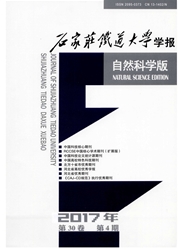

 中文摘要:
中文摘要:
The dynamic behavior of a bridge-erecting machine,carrying a moving mass suspended by a wire rope,is investigated.The bridge-erecting machine is modelled by a simply supported uniform beam,and a massless equivalent 'spring-damper' system with an effective spring constant and an effective damping coefficient is used to model the moving mass suspended by the wire rope.The suddenly applied load is represented by a unitary Dirac Delta function.With the expansion method,a simple closed-form solution for the equation of motion with the replaced spring-damper-mass system is formulated.The characters of the rope are included in the derivation of the differential equation of motion for the system.The numerical examples show that the effects of the damping coefficient and the spring constant of the rope on the deflection have significant variations with the loading frequency.The effects of the damping coefficient and the spring constant under different beam lengths are also examined.The obtained results validate the presented approach,and provide significant references in the design process of bridgeerecting machines.
 英文摘要:
英文摘要:
The dynamic behavior of a bridge-erecting machine, carrying a moving mass suspended by a wire rope, is investigated. The bridge-erecting machine is modelled by a simply supported uniform beam, and a massless equivalent "spring-damper" system with an effective spring constant and an effective damping coefficient is used to model the moving mass suspended by the wire rope. The suddenly applied load is represented by a unitary Dirac Delta function. With the expansion method, a simple closed-form solution for the equation of motion with the replaced spring-damper-mass system is formulated. The characters of the rope are included in the derivation of the differential equation of motion for the system. The numerical examples show that the effects of the damping coefficient and the spring constant of the rope on the deflection have significant variations with the loading frequency. The effects of the damping coefficient and the spring constant under different beam lengths are also examined. The obtained results validate the presented approach, and provide significant references in the design process of bridgeerecting machines.
 同期刊论文项目
同期刊论文项目
 同项目期刊论文
同项目期刊论文
 期刊信息
期刊信息
